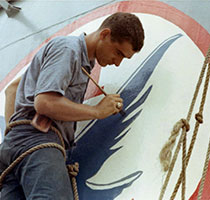Gemini T-5 Standby Recovery Mission
USS Taylor (DD 468) was assigned to be a GEMINI space capsule recovery ship during the period of 21–29 August 1965. In preparation for this assignment, Pearl Harbor Naval Shipyard installed a large recovery rig on the port side of the fantail. I guess the design philosophy was “just stick it somewhere” because the rig increased the ship’s normal 3 degree port list to 5 degrees.
Before proceeding too far with this story I will remind everyone that there were no cell phones in 1965. In fact the USS Taylor had only one telephone and that was a dial phone temporarily lashed to the quarterdeck.
As part of the Gemini assignment the Taylor was placed on a four-hour standby for the entire period. The question now became how to manage liberty for the crew; i.e., just how much liberty can the crew have and still be available to get underway within 4 hours? The solution was obvious. We would set up a three section watch bill and put a sign-out log on the quarterdeck. Any crewman going off the ship would be required to provide a contact phone number where he could be reached. Thus, liberty would be normal with the exceptions of the phone contact requirement – problem solved.
As you might have guessed, during one of the first evenings of our assignment period the call came down. We were to get underway for a recovery ASAP. The XO rushed to the quarterdeck, grabbed the log book, and called the first number. He reached an organization called “Dial a Prayer”. With a rotary dial phone in his hand and “Dial a Prayer” as the initial response, the XO soon realized just how much trouble we were in. The XO quickly divided the sign-out log pages up and assigned pages to one or two others who ran off to find additional phones. After eliminating the listings that had the number for “Dial a Prayer”, the result was some limited success in getting a bartender or two to roust people out of the base EM Club, a bar or two on Hotel/S**T street, and a few other hangouts. In practical terms, there were just too many phone calls to make and not enough time to make them – this would have been true even if no one was making a statement of defiance with his phone listing.
We got underway with essentially an enhanced duty section, probably about 1/2 of the crew. I recall standing a watch as Engineering Officer of the Watch, a scary circumstance for a freshly minted Ensign. Even though I had the training to handle the watch, I certainly didn’t have the experience. Usually a Chief or First Class Machinist Mate with years of experience stood that watch. Luckily I, and the engineering plant, survived the watch and, I believe, we were back in port before my watch rotation came up again.
All in all, we were called out twice and each time we came home without a capsule or an astronaut. I do recall that on one of the missions the USS Chipola (AO 63) highlined the body of a deceased sailor over to us. We stored the body in the reefers. Almost needless to say, having a corpse stored in with the provisions became the source of a plethora of sick humor concerning the menu on the mess decks. We would have made Hannibal Lecter proud.
If anyone has a photo of the USS Taylor (DD 468) with the Gemini recovery rig on it, I would love to get a copy of it – even if the ship is listing – so that we can post it on our website and enhance our photographic history. I would also welcome the thoughts of anyone who could supplement or correct any aspects of my memory of this event.
James G. O’Neill, III., CDR (USNR, Ret)

